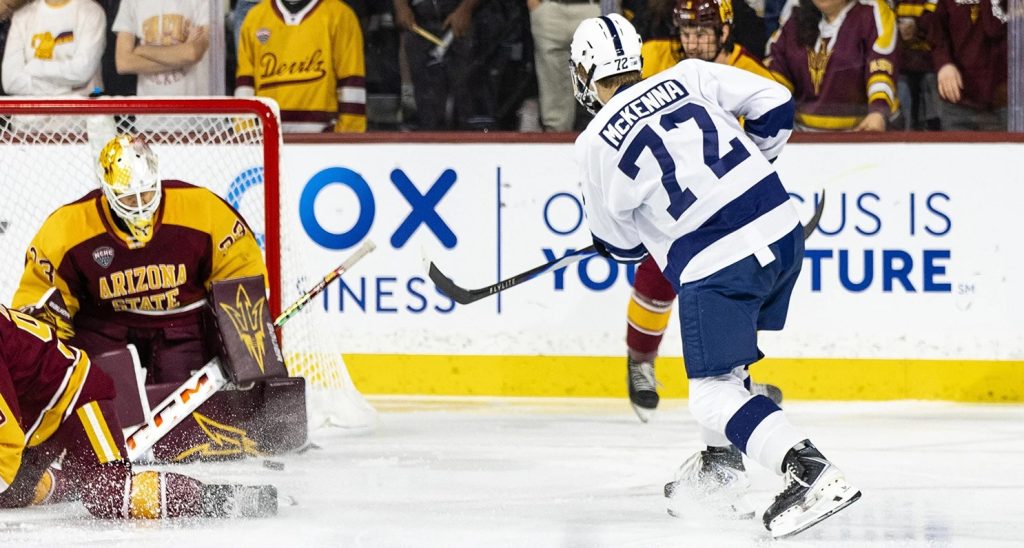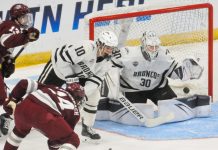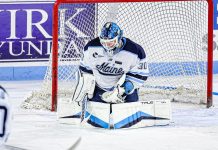
Each week during the season, we look at the big events and big games around Division I men’s college hockey in Tuesday Morning Quarterback.
Jim: Ed, it’s so good to be back for the 2025-26 season and the first weekend of games certainly didn’t disappoint.
While a lot of teams played exhibitions and remained idle this weekend, there were some high-end matchups. And the schedule gods really rewarded college hockey fans with one of the biggest storylines right from the jump.
Gavin McKenna, the Canadian forward who played for Medicine Hat in the WHL last year, is the highest-profile recruit from the CHL. And this weekend, he was on the main stage.
Penn State traveled to Arizona State for a top-20 matchup out of the gate. Both games delivered: two great third-period comebacks for the now-No. 4 Nittany Lions delivered the sweep on the ice.
But this matchup drew massive eyeballs when NHL Network decided to simulcast the Arizona State feed of the game. They also placed it on their YouTube channel that has two million subscribers.
Talk about a pretty big rise we are feeling right away from CHL players coming to the NCAA. Is this even bigger than you ever imagined?
Ed: I’m not sure how big I imagined it, but when the intrigue started last spring over who would land McKenna (and the dollars involved) you just knew it would be a big deal.
I think the excitement and the perceived level of play and NHL-fan interest in college hockey are going to get a big boost from all of this CHL talent. The exposure on a bigger stage will also show hockey enthusiasts what a great game college hockey is.
We’re also going to see an overall upgrade in talent with the influx of major junior players beyond just the stars. While there are a few standout former CHL players who have made the jump to college hockey at a young age — McKenna doesn’t turn 18 until December 20 — there are also players aging out of major junior and entering NCAA hockey at age 20 or 21. And in some cases transferring after one or more years of USports, Canadian university hockey.
It’s a not-insignificant number, somewhere in the vicinity of 325 or 330 former CHL players on NCAA rosters this season. Our USCHO podcast colleague Derek Schooley, head coach at Robert Morris, says in our episode dropping Wednesday, “ It’s just the pool is so big, it’s like the ocean now, and it’s a good thing for our game.”
If this season was hard to imagine, how much more difficult will it be to forecast the impact on the next few s
Jim: What you just pointed to might be the most positive development: all of this attention is coming despite the ability for college hockey (and leagues and teams in the CHL for that matter) to plan and strategize what works best.
While allowing major junior players college eligibility has been long rumored, the actual allowance came quite suddenly. So five, even 10 years down the road, I think this changes the complete North American hockey landscape.
There will become more defined roadmaps to the NHL, similar to other professional North American sports leagues. North American players will be much more likely to begin their top tier play in the CHL and then matriculate at college prior to their NHL careers. This will make the CHL younger and will likely hurt some of the junior leagues in the country, but it should strengthen the college product to place it on par talent-wise with basketball and football.
That’s just my belief, but does this seem like too much hyperbole? Or can you already see the blueprint like I do?
Ed: I think you’re right on the money.
Toss in NIL bucks and the House v. NCAA settlements, and we’re entering an era that couldn’t have been imagined two or three years ago. In this column around the time of the CHL decision, you and Paula C. Weston noted the prediction on our Weekend Review podcast that it would be three to five years before the impact of CHL eligibility could be sorted out.
But I don’t think we were expecting things to happen so quickly.
We first heard rumblings about CHL eligibility at the Frozen Four in Tampa in 2023. In St. Paul in April 2024, the buzz around the tournament was that the coaches would discuss it in their meeting in Naples that May. Some prominent figures around the sport were actively promoting it, including CCHA commissioner Don Lucia. By November of last year, it was a done deal.
I think we can see some early indications of where things are headed, and it will be a little different than this season. First of all, we’re probably going to see USports transfers peak early — maybe even this season — because in the future, those players could go straight to NCAA hockey. I think we’ll also see bigger battles among top programs for elite talent.
However, we also may see something unexpected for players. The transfer portal has made the idea of a player staying loyal to one program almost a relic, especially if the grass seems a bit greener elsewhere.
If I am a head coach with an ocean to recruit from, why should I show loyalty to an underperforming player when players can pretty much come and go as they please? I think that’s part of the blueprint, too.
But I’m looking forward to the day when more than one-third of the NHL comes from NCAA ranks. How soon will we see that top 50%?
Jim: That’s a really good question. I think 8-10 years is what it will take to get most of the NHL talent to come through the college ranks for at least one season.
That said, what you just described makes college hockey sound more like the NHL without the contract commitments. I guess we have known this is coming for the last few seasons. And maybe we have to except that the home-cooking-like feel that we always got from college hockey (and college sports in general) is going the way of much else in this world – bigger better and more commercial.
And if I were to say that is bad, it would make all of the excitement that I opened this piece with extremely hypocritical.
I think I’m okay letting go of some of the comforts of the old to experience what looks like a bright future. You’ve been around this game longer than I have. Are you ready to accept the good with the bad?
Ed: At some point in my time following college hockey (and in life in general) I realized that change was inevitable, and so I could either be quixotic in fighting it, or grumble about “how the old days were better,” or I could accept change and even try to embrace it.
I have had a couple of coaches suggest to me having contracts between schools and players. If we’re going to be “bigger, better and more commercial,” as you said, then why not go the whole distance and provide protections and stipulations for both parties?
But overall, I’m with you. Sometimes we do have to let go of the old. I know there are fans who still pine for the old WCHA and still others who lament the shootout. But if I can finally let go of my misgivings about the designated hitter after 50 years, maybe those fans can let those old comforts go too.
We’re watching the most skilled and most exciting college hockey ever. That’s something to celebrate.


